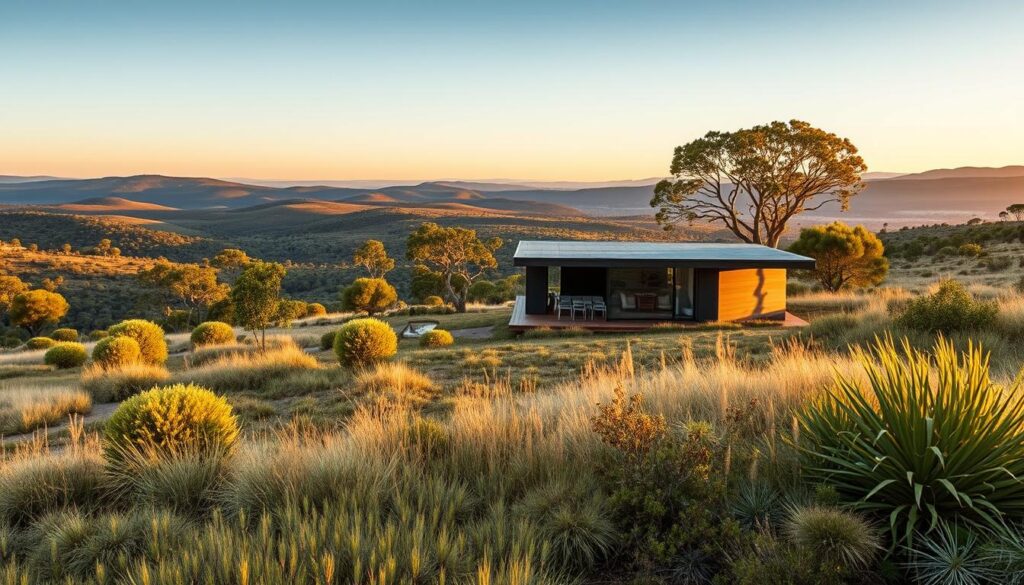Did you know Australia’s resource sector wastes over $1.2 billion annually because of delays in setting up traditional worker accommodations? In remote areas, mining, energy, and infrastructure projects face big challenges. Traditional building methods often fail due to harsh conditions, logistical issues, and a lack of labour.
Prefabricated solutions can cut deployment times by up to 50% compared to traditional builds. Imagine having living quarters ready before heavy machinery arrives. This is happening in the Pilbara and Queensland’s coal basins.
What makes these structures truly game-changing? Their adaptability. They can change as project needs do – whether it’s scaling up or changing safety protocols. For Australian project managers, this flexibility is business-critical.
Building in Australia's remote areas is tough. It needs solutions that can handle vast distances and extreme weather. Traditional methods often fail, making smarter worker housing a must.
CSIRO research shows a big problem: transporting materials 3,000km from coastal cities increases costs by 35-50%. Traditional "dongas" are not practical when spare parts take a week to arrive on rough roads.
Summer temperatures can reach 50°C, warping untreated steel. Flash floods can destroy temporary structures. We design worker houses with:
Building on-site in the Tanami Desert has 63% more weather delays than coastal projects. Modular construction reduces this risk by finishing 80% of work in factories.
A 2023 mining camp project saw costs rise by 140% using traditional methods. This was due to:
Modular worker housing solves these problems with precise prefabrication and efficient material transport.
Traditional building methods can't keep up with Australia's remote site needs. Modular construction changes the game by combining precision with smart design. This is how we do what fixed-site builders can't.
Our method starts in a workshop, cutting down on weather delays by 83%. The benefits are clear:
We tailor modules for Australia's harsh conditions with:
Our BIM models test designs against Kimberley monsoons, ensuring drainage systems handle 300mm/hour downpours. For Pilbara sites, we include solar-ready wiring and double-glazed windows that block 92% of radiant heat.
In Australia's remote areas, tight deadlines often challenge traditional building times. Modular housing changes this by allowing simultaneous site preparation and factory production. This is a big win for projects with short timelines.
While ground crews prepare the site, teams in the factory build housing modules. This way, there's no dead time like in traditional building. At Fortescue's Cloudbreak iron ore expansion, this method helped house 1,200 workers 11 weeks early.
The Pilbara project achieved:
Modular construction cuts on-site assembly time by up to 60%. It offers several benefits:
Recent projects show:
| Project Type | Traditional Build | Modular Solution |
|---|---|---|
| 200-bed camp | 11 months | 4.5 months |
| Dining facilities | 6 months | 2.2 months |
This fast timeline lets companies mobilise workers faster. It also cuts down on risks of remote-area construction. Clients can use the saved time for other important tasks, leading to more efficiency in their projects.
Building in Australia's remote areas needs careful budgeting. Modular construction helps with predictable budgeting by managing costs like workforce, materials, and transport. It offers value where traditional methods struggle.
Building in the Outback can be expensive due to high labour costs. Our method? We do 80% of construction in controlled factory settings before modules reach the site. This greatly reduces:
Teams do precision work like plumbing and electrical systems in climate-controlled factories. This work is 30% faster than on-site methods, saving a lot of time.
Traditional site-built projects in remote areas can waste up to 15% of materials. This is due to:
Our automated cutting systems achieve 98% material utilisation. Digital templates ensure perfect fits - no trial-and-error on dusty sites.
Moving materials across desert tracks can be very expensive. We tackle this with:
For Newmont Goldcorp's Tanami Desert project, our containerised bathroom pods and foldable wall systems cut truckloads by 40%. This saved 23% compared to traditional transport methods.
"The modular system cut our accommodation costs without compromising worker comfort. Transport efficiency surprised even our most experienced site managers."
Remote projects often change quickly. We create worker house solutions that adjust easily. This way, your accommodation keeps up with project needs.
Modular worker housing is perfect for projects that grow fast. Our units are different from fixed buildings. They let you:
The Santos' GLNG project shows how flexible we can be. They changed their 300-bed worker house four times in 18 months. They even turned recreation areas into COVID-safe medical wings. This saved them 22% on costs compared to traditional buildings.
In Australia's remote areas, space is a big challenge. Our modular designs make the most of every inch. They turn single-purpose areas into:
Dining halls can become telehealth clinics with just a few changes. Recreation rooms can turn into emergency briefing centres during cyclones. This chameleon-like adaptability makes every square metre count for your team.
"Our modular medical unit conversions during the pandemic kept projects running when fixed facilities couldn't adapt."
Australia's remote areas need building solutions that protect the environment and support work. Modular housing offers a balance through three main sustainability areas:

Old construction methods often harm the environment. They need:
Modular houses use screw pile foundations that barely mark the ground. This method was used in Western Australia's Ningaloo Reef. It helped keep the coast safe while housing 300+ workers. 92% of structures were designed for easy moving as per EPA rules.
Our setup takes 48-72 hours with pre-made modules. This quick setup:
Off-grid sites benefit from systems that cut down on diesel use:
Northern Territory mining camps with our solar modules saw big changes:
| Metric | Improvement |
|---|---|
| Energy costs | Reduced 78% |
| Carbon emissions | Lowered 62 tonnes/year |
When projects end, modular houses don't go to landfill. They:
In Queensland's Surat Basin, 85% of old worker homes now help new projects near Mount Isa. This way, temporary homes become long-lasting assets instead of just being used once.
Australia's remote sites need more than just strong houses. They need buildings that follow strict rules and fit local conditions. Modular construction makes this easier by using precise engineering and understanding local cultures. This ensures safety and legal rules are followed without losing efficiency.
Our modular units get full NCC certification in the factory. They use fire-safe materials and are energy-efficient. This method allows:
| Feature | Traditional Construction | Modular Solution |
|---|---|---|
| Ember Protection | Retrofitted | Factory-Installed |
| Fire-Resistant Cladding | Weather-Dependent Installation | Climate-Controlled Application |
| Sealed Penetrations | On-Site Adjustments | Precision-Engineered |
We work with Traditional Owners in several ways:
Modular housing's removable nature fits with Indigenous land management. It does this by:
“Modular designs let us meet AS/NZS 1170 wind standards while maintaining cultural protocols,” says our lead engineer. This approach has helped us successfully deploy in Aboriginal-owned mining leases in Western Australia.
Creating workspaces that are good to live in and supporting local communities is smart. Modular worker housing does this by using new designs. These designs tackle Australia's unique workforce issues.
Modern worker house units focus on people, not just basics. Rio Tinto found a 41% better mental health for workers in private units compared to shared dongas.

| Feature | Modular Worker House | Traditional Dongas |
|---|---|---|
| Temperature control | Built-in HVAC systems | Portable fans only |
| Privacy | Single-occupancy rooms | 4-6 person shared spaces |
| Space per worker | 12-15m² | 6-8m² |
| Mental health impact | 41% better outcomes* | Baseline satisfaction |
*Rio Tinto 2023 workforce survey data
Our designs fight off loneliness with:
This is different from dongas where workers share facilities.
Modular construction brings regional manufacturing jobs and cuts down on fly-over workforces. It has big benefits like:
Places like Gladstone and Karratha have doubled their manufacturing thanks to modular housing.
Australia's remote projects need solutions that are fast, strong, and flexible. We show how modular construction has excelled in three tough environments.
A major LNG operator needed housing quickly. Our team built a 2,000-bed village in just 12 weeks, even during the wet season. Key achievements include:
Our Chevron Wheatstone LNG project accommodation stayed operational during Cyclone Damien's 285km/h winds. The secret? Engineered modular designs that feature:
| Feature | Traditional Units | Our Modular Solution |
|---|---|---|
| Wind Rating | Category 3 | Category 5+ |
| Power Backup | Diesel generators | Hybrid solar-battery-diesel |
| Recovery Time | 3-5 days | Immediate operation |
At a remote road construction site, we cut diesel use by 63% with smart technology:
"The hybrid system cut our fuel costs by $28,000 monthly while maintaining 99.7% power reliability," said the project's site manager.
Setting up modular homes in Australia's remote areas is not just about tech skills. It's about finding creative solutions for local issues. We've learned to tackle three big challenges over the years.
Getting modular homes across the Outback needs careful planning. Our special transport system for modular house in remote QLD coal sites includes:
Australia's diverse workforce needs homes that respect their lifestyles. Our designs meet these needs by:
In the tropical Northern Territory, we fight humidity with:
Coastal areas can damage traditional buildings in 5-7 years. Our modular house in remote setups use:
In Queensland's salty air, we use:
Modular construction has shown its worth in Australia's toughest spots. It works well in Western Australian mining camps and Northern Territory infrastructure. Prefabricated worker houses solve distance, climate, and logistical issues while following strict building codes.
They meet project needs and improve worker wellbeing. This method is flexible and effective.
In Queensland's Surat Basin gas fields, modular units cut on-site labour by 40%. Rio Tinto's Pilbara operations set up 200-bed facilities in 12 weeks. These examples show modular construction saves money without losing quality.
We handle every step, from site checks to decommissioning. We manage transport, land consultations, and energy-efficient designs. This service model helps clients avoid problems in harsh areas.
Modular construction is a smart choice for tight deadlines or complex sites. It's fast, scalable, and sustainable for Australia's sectors. As work demands change, these solutions will keep operations running smoothly.
Find out how our modular systems can make your next project easier. Contact us for site planning advice and data from our Australian projects.


